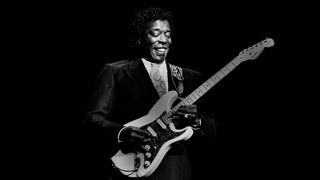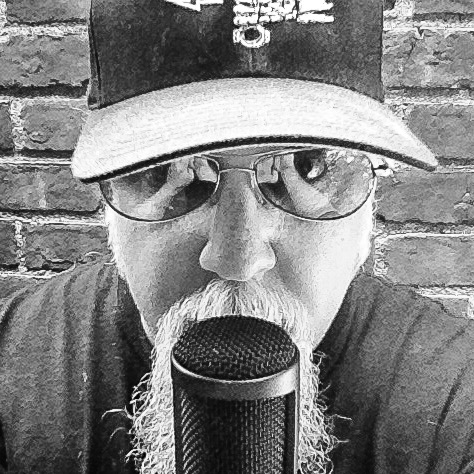Youtube Buddy Guy Dam Right I Got the Blues Backing Tracking
The secrets behind Buddy Guy's tone on Damn Right, I've Got the Blues

When Buddy Guy recorded Damn Right, I've Got the Blues in 1991, he had not been in a studio to record his own music for nearly a decade.
Even though numerous guitar legends like Jeff Beck, Eric Clapton, Stevie Ray Vaughan and Johnny Winter had praised him as a primary influence, Guy missed out on the Eighties blues revival, seeming content to slug it out on the club circuit or occasionally make guest appearances on bigger stages.
With Damn Right, I've Got the Blues, Silvertone Records and producer John Porter sought to finally earn Guy the acclaim he deserved with a proper "comeback" recording that showcased him at his finest.
Appropriate for an electric blues guitarist with a classic Chicago pedigree, Guy used a bare-bones, stripped-down rig consisting of just a couple of tweed Fender amps and a Fender Stratocaster.
"When I first worked with Buddy, I brought my own battered '58 tweed Bassman and tweed Deluxe to the sessions," recalls John Porter. "As far as guitars go, I called the Fender guys in London and asked them to send a couple of Strats to the studio. Buddy was playing a Guild at the time, but I always considered him and Otis Rush as the two guys who made the Strat an iconic blues guitar.
"Perhaps I shouldn't have interfered, but I wanted him to have that sound. Fender sent over two Strats, including an Eric Clapton model with a blonde finish and tortoiseshell pickguard, which is the one that Buddy used. He told Fender that he dug it and took it home with him after the sessions. I believe it became the basis for his signature model that Fender introduced a few years later."
Fender sent over two Strats, including an Eric Clapton model with a blonde finish and tortoiseshell pickguard. I believe it became the basis for his signature model
For the album's title track, Guy plugged the Clapton Strat directly into the 1958 Fender Bassman and turned every control way up except for the bass, which was set around 2.
Those settings combined with additional boosted treble from the Clapton Strat's TBX tone circuit gave Guy a very aggressive, cutting tone that slices right to the front of the mix.
Guy started the intro by playing through the neck pickup, but at key moments during the solos he switched to the bridge pickup for enhanced percussive attack, particularly during his second solo just past the three-minute mark.
He also manipulated the volume control almost continuously, backing off for fills during the verses.
With a guitar rig this stripped down and simple, the true key to reproducing Guy's tone lies with a very aggressive pick attack and firm pressure from the fretting hand, particularly when bending notes and performing pull-offs and hammer-ons
Get the sound, cheap!
Fender Buddy Guy Standard Stratocaster

Fender Blues Deluxe Reissue

TONE TIP: Although the Buddy Guy Standard Stratocaster does not have the Clapton Strat's TBX and Active Mid Boost features, these tones can be replicated by a slight gain boost on the amp via the Drive control and keeping the bass tone control setting low for enhanced treble cut.
Original gear
GUITAR: 1988 Fender Custom Shop Eric Clapton Stratocaster with Lace Sensor Gold pickups (individual neck and bridge pickup settings used throughout), Volume: setting varies, but mostly at 10, TBX Tone: 7, Active Mid Boost: 2
AMPS: 1958 Fender Bassman (Presence: 12, Middle: 12, Bass: 2, Treble: 11, Vol. Bright: 10, Vol. Normal: 0, Bright 1 input) with four Jensen P10R alnico 10-inch speakers
EFFECTS: none
STRINGS/TUNING: Ernie Ball Power Slinky .011 - .048/Standard
PICK: Jim Dunlop celluloid Triangle heavy

Chris is the co-author of Eruption - Conversations with Eddie Van Halen. He is a 40-year music industry veteran who started at Boardwalk Entertainment (Joan Jett, Night Ranger) and Roland US before becoming a guitar journalist in 1991. He has interviewed more than 600 artists, written more than 1,400 product reviews and contributed to Jeff Beck's Beck 01: Hot Rods and Rock & Roll and Eric Clapton's Six String Stories.
Youtube Buddy Guy Dam Right I Got the Blues Backing Tracking
Source: https://www.guitarworld.com/features/the-secrets-behind-buddy-guys-tone-on-damn-right-ive-got-the-blues
0 Response to "Youtube Buddy Guy Dam Right I Got the Blues Backing Tracking"
Post a Comment